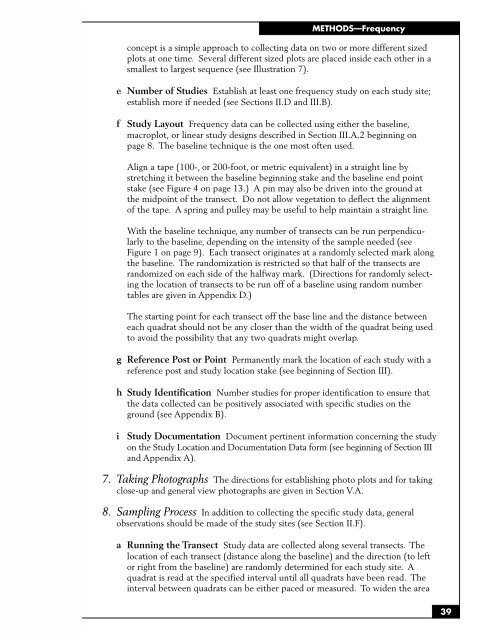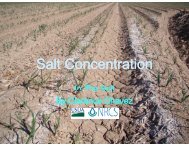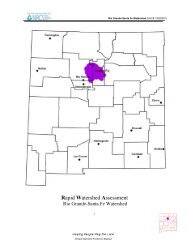SAMPLING VEGETATION ATTRIBUTES - New Mexico NRCS - US ...
SAMPLING VEGETATION ATTRIBUTES - New Mexico NRCS - US ...
SAMPLING VEGETATION ATTRIBUTES - New Mexico NRCS - US ...
Create successful ePaper yourself
Turn your PDF publications into a flip-book with our unique Google optimized e-Paper software.
METHODS—Frequency<br />
concept is a simple approach to collecting data on two or more different sized<br />
plots at one time. Several different sized plots are placed inside each other in a<br />
smallest to largest sequence (see Illustration 7).<br />
e Number of Studies Establish at least one frequency study on each study site;<br />
establish more if needed (see Sections II.D and III.B).<br />
f Study Layout Frequency data can be collected using either the baseline,<br />
macroplot, or linear study designs described in Section III.A.2 beginning on<br />
page 8. The baseline technique is the one most often used.<br />
Align a tape (100-, or 200-foot, or metric equivalent) in a straight line by<br />
stretching it between the baseline beginning stake and the baseline end point<br />
stake (see Figure 4 on page 13.) A pin may also be driven into the ground at<br />
the midpoint of the transect. Do not allow vegetation to deflect the alignment<br />
of the tape. A spring and pulley may be useful to help maintain a straight line.<br />
With the baseline technique, any number of transects can be run perpendicularly<br />
to the baseline, depending on the intensity of the sample needed (see<br />
Figure 1 on page 9). Each transect originates at a randomly selected mark along<br />
the baseline. The randomization is restricted so that half of the transects are<br />
randomized on each side of the halfway mark. (Directions for randomly selecting<br />
the location of transects to be run off of a baseline using random number<br />
tables are given in Appendix D.)<br />
The starting point for each transect off the base line and the distance between<br />
each quadrat should not be any closer than the width of the quadrat being used<br />
to avoid the possibility that any two quadrats might overlap.<br />
g Reference Post or Point Permanently mark the location of each study with a<br />
reference post and study location stake (see beginning of Section III).<br />
h Study Identification Number studies for proper identification to ensure that<br />
the data collected can be positively associated with specific studies on the<br />
ground (see Appendix B).<br />
i Study Documentation Document pertinent information concerning the study<br />
on the Study Location and Documentation Data form (see beginning of Section III<br />
and Appendix A).<br />
7. Taking Photographs The directions for establishing photo plots and for taking<br />
close-up and general view photographs are given in Section V.A.<br />
8. Sampling Process In addition to collecting the specific study data, general<br />
observations should be made of the study sites (see Section II.F).<br />
a Running the Transect Study data are collected along several transects. The<br />
location of each transect (distance along the baseline) and the direction (to left<br />
or right from the baseline) are randomly determined for each study site. A<br />
quadrat is read at the specified interval until all quadrats have been read. The<br />
interval between quadrats can be either paced or measured. To widen the area<br />
39




